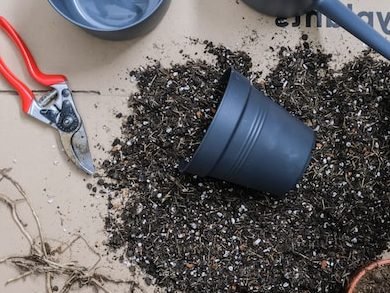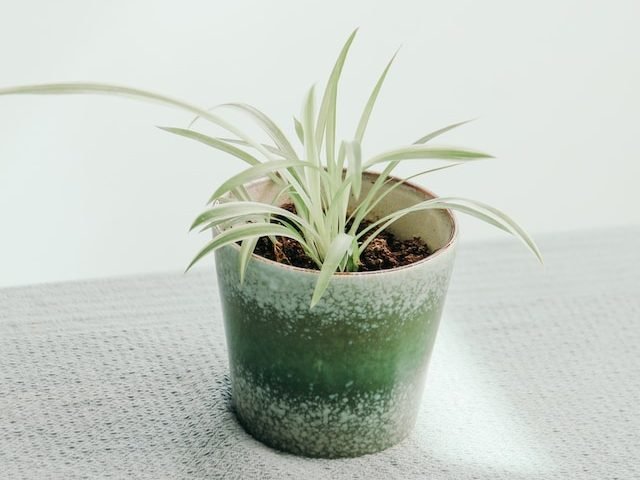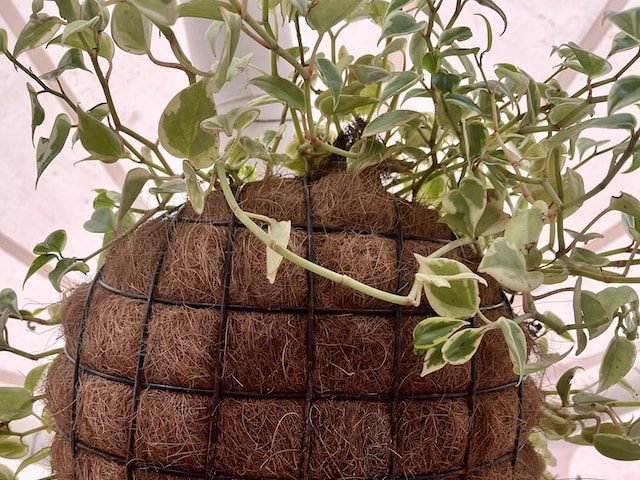Soil Mix

If you’re on the hunt for an innovative and low-maintenance method to care for your indoor plants, you’ve probably come across the term ‘Leca’. But what is it really? How does it work with houseplants and most importantly, how do you use it?
Below we’ll explore what Leca is, its benefits and potential downsides, how to choose and prepare it, and finally, how to replant your houseplants in it.
We’ll also guide you through monitoring and adjusting moisture levels, making propagation so much easier.
Contents
- What is Leca?
- Why is Leca beneficial for Houseplants?
- The Downsides of Leca for Houseplants
- Choosing the Right Type of Leca for your Houseplants
- Preparing Leca for Use with Houseplants
- How to Repot your Houseplants using Leca
- Monitoring and Adjusting Moisture levels in Leca
- Using Leca as a Propagation Medium for Houseplants
- Frequently Asked Questions
What is Leca?
Leca is an acronym for Light Expanded Clay Aggregate. It’s essentially small balls of clay that have been heated to such a high temperature that they expand.
This process forms a hard shell on the outside, while the inside remains porous.
The result? A growing medium that’s lightweight, airy, and fantastic at holding onto both moisture and air. And the best part is that Leca is reusable, making it a sustainable choice!
Note: Leca is also referred to as clay pebbles, clay balls, hydroton, or hydrocorn.
Properties of Leca
- Lightweight: As the name suggests, Leca is light due to the air pockets created during its manufacturing process. This can make managing larger indoor plants far more manageable.
- Porous: The porous nature of Leca means it’s excellent at absorbing water. This is beneficial for delivering moisture and nutrients to your plant roots gradually.
- Reusable: Unlike soil or other potting mediums, Leca can be cleaned and reused countless times, making it a cost-effective and environmentally friendly alternative.
- pH neutral: Leca is pH neutral, which means it doesn’t affect the acidity or alkalinity of the water or nutrient solution your plants are growing in.
Why is Leca beneficial for Houseplants?
The benefits of using Leca for your houseplants are plentiful.
First off, Leca is reusable. Unlike some other substrates, it doesn’t break down over time, which means you can sterilize and reuse it for many planting cycles to come.
Due to its excellent water-retaining capability, this lightweight expanded clay aggregate can soak up and gradually release moisture. This slow moisture release greatly reduces the risk of overwatering, and if you forget a watering day or two, it can provide a buffer.
Leca can also actually help prevent bug infestations. Because it holds no organic matter for them to feed upon, it’s a not-so-friendly environment for pests like gnats and mites.
And if that wasn’t enough, Leca is also great for root aeration. The spaces between the Leca balls allow air to circulate around the roots of your plants, which can stimulate healthier and more robust growth.
The Downsides of Leca for Houseplants
One potential caveat we need to address when using LECA for houseplants is the initial investment cost.
While LECA itself is not expensive, the cost of the materials needed to correctly use LECA can add up.
This includes things like clay pebbles, water pH tester, and the time and effort to continuously monitor and adjust water levels.
Other areas to consider include the necessity for frequent water changes. Unlike soil that can be left unchanged for a while, water in LECA requires regular observation and adjusting in order to maintain the necessary moisture levels and keep your houseplants happy.
Another consideration to bear in mind, is that not all plants do well in LECA. Some houseplants might struggle with the transition or may not thrive in a soil-less environment. It’s always best to do research on what your specific plant prefers before making the switch.
Lastly, due to LECA’s nature of soaking up and releasing water, it creates a damp environment that may lead to the growth of mold or algae. However, this can be easily controlled by cleaning the LECA pebbles and the plant pot frequently and ensuring your plant gets enough light.
Choosing the Right Type of Leca for your Houseplants
- Smaller sized Leca: These are typically between 8mm to 16mm in diameter and work great with smaller houseplants that have delicate root systems. Indoor herbs, succulents and flowering plants like African violets thrive with this size.
- Medium sized Leca: These pebbles range anywhere from 16mm to 18mm. They’re ideal for larger houseplants that need more space for root expansion and are also suitable for the succulents and herbs mentioned earlier.
- Larger sized Leca: With diameters over 18mm, these are perfect for big houseplants or outdoor plants that have vigorous root systems. Plants that require a lot of water, like tropical houseplants and ferns, will benefit from these.
Similarly, it’s important to keep in mind that different brands may have different quality standards for their Leca. You may find upon examination that some brands polish their pebbles for a smooth finish while others leave them with a rough, porous texture.
So, should you go for the polished or unpolished? Our advice is to opt for the unpolished ones. The rough texture provides a better condition for root growth and anchors the plants evenly.
Preparing Leca for Use with Houseplants
Step 1: Soaking the Leca
This process helps to remove any dust or impurities that may be present. All you need to do is to place your Leca pebbles in a bowl of water for up to six hours or overnight.
Soaking not only cleans the pebbles but also allows them to absorb water, which is crucial for the optimum growth of your plant as Leca will serve as your plant’s primary water source.
Step 2: Rinsing the Leca
After soaking, it’s important to rinse your Leca. Simply drain the water from the bowl and run each Leca pebble under a stream of clean, warm water.
While rinsing might seem repetitive, this step ensures that any remaining dust is completely removed from the Leca.
Step 3: Buffering the Leca
The next step in the setup process is buffering the Leca. Buffering refers to the process of soaking Leca in water mixed with a nutrient solution, usually a balanced liquid houseplant fertilizer.
By doing so, the Leca acquires essential minerals needed by your plant.
Step 4: Final Rinse and Drain
Once buffering is done, don’t forget to give your Leca one last rinse. You can then allow the Leca to drain in a colander or a mesh bag until it stops dripping.
How to Repot your Houseplants using Leca
Repotting your beloved houseplants using Leca might initially seem daunting but here’s a simple step-by-step guidance to ensure a successful transition.
Step 1: Select your Plant
Choosing the right plant for this process is crucial. Beginners might want to start with hardy plants that adapt well to different conditions, like Pothos or ZZ plants.
If you’re more experienced, feel free to experiment with your favorites. However, avoid succulents and water-sensitive plants when starting out.
Step 2: Remove Soil from the Plant’s Root
Carefully remove the plant from its current pot and gently shake off the existing soil. Rinse the roots under lukewarm water to remove any remaining particles.
This step might require a level of patience – especially with plants having a dense root system. Remember, we want our roots as clean as possible to reduce the risk of disease transmission into our Leca environment.
Step 3: Size your Leca Base
Start by placing a layer of your prepared Leca at the bottom of the new pot. This should be approximately 1/4th of the pot, but it can vary depending on the plant and pot size.
Step 4: Set your Plant
Place your plant on this layer and ensure it’s stable enough before proceeding. Remember, the plant’s crown should stay above the Leca, as submergence might lead to rotting.
Step 5: Complete the Leca Top-Up
Fill the rest of the pot with Leca, up to the base of the plant. You can gently shake the pot to help the Leca settle and fill any gaps.
Be sure not to pile it too high – the top of the Leca should sit about an inch below your pot’s edge.
Step 6: Water Your Plant
Once your houseplant is nestled comfortably in its new Leca home, it’s time to water it using your prepared nutrient solution.
The level of water should be kept around the base where the Leca ends.
Note: Avoid getting the plant’s leaves or stems wet, to well combat any possibilities of rotting.
Monitoring and Adjusting Moisture levels in Leca
Getting the moisture levels right is a crucial component of successfully growing houseplants in Leca. Too little water and your plant might dry out, too much and it becomes vulnerable to root rot.
Firstly, it’s important to remember that Leca isn’t like traditional potting soil – it doesn’t absorb water in the same way. Instead, Leca acts as a medium for water to surround your plant’s roots, providing them with moisture as needed.
Water is poured into a reservoir at the bottom of the pot, typically to a depth which covers around one fifth of the Leca pellets. The tiny spaces between and within the pellets carry the water upwards in a process known as capillary action.
Now, you might be wondering, “how often should I refill the reservoir?”. Well, this varies greatly depending on the type of plant, the environment, and the size of your Leca.
However, a good rule of thumb is to wait until the top layer of Leca appears dry, and then refill the reservoir. It’s also wise to ensure your plant isn’t sitting in stagnant water by pouring out any excess after a few hours.
Troubleshooting Common Moisture problems
Here’s a quick rundown of common moisture-related problems and solutions:
- Brown leaf tips: This is often a sign of dryness. Your plant may need more frequent watering, or a deeper reservoir.
- Yellowing leaves: This can indicate overwatering. Try waiting a little longer between refills, or reducing the size of the reservoir.
- Root rot: If you notice a foul smell, or your plant’s roots appear mushy and brown, this could be a result of overwatering. Unfortunately, this can be fatal to your plant if not addressed quickly. Immediately remove the rotting parts, let the roots air out and apply a fungicide if possible.
Using Leca as a Propagation Medium for Houseplants
Choosing and Preparing Your Cuttings
First things first, you need to select cuttings from your houseplant. Be sure to choose healthy, disease-free stems or leaves.
Then, prepare them by removing any extra leaves and leaving just a few at the top. Experience proves this step can help conserve the plant’s moisture.
Note: You can optionally dip the cutting end in rooting hormone, but it’s not necessary as LECA does a wonderful job promoting root growth by itself.
Preparing LECA for Planting
After preparing your cuttings, it’s time to prep our LECA. Reuse some of the previously buffered LECA balls or prepare fresh ones as described in earlier sections.
Keep in mind, a smaller pot or container is beneficial during this phase as it helps maintain moisture levels appropriately.
Planting Your Cuttings in LECA
With your LECA and cuttings ready, it’s planting time! Make a little hole in the LECA, put the cutting in, and surround it with LECA balls.
The top of the LECA should sit at the same level as the bottom of the cutting. Ensure your cutting has solid contact with the LECA to facilitate effective moisture absorption.
Maintenance
Just as with a full-grown houseplant, you’ll want to maintain a water level around 1/3 of your container or pot. Try not to let it go dry, but also avoid over-watering. Adjust as necessary.
After detecting root growth, you can continue to leave the cutting in the LECA for more development or transplant it into another medium.
Frequently Asked Questions
Do all types of houseplants work well with Leca?
Generally, many houseplants can thrive in Leca, but there are a few exceptions. Drought-tolerant plants like succulents and cacti or plants preferring a dry environment might not be the best fit due to the moist condition that Leca creates.
As always, do your research and observe how your specific plant responds.
How frequently should I water my Leca repotted plant?
The watering schedule varies depending on the type of your plant and its specific needs. Typically, you’ll water your plant once the Leca becomes dry to the touch or the water reservoir is empty. This could be every few days or once a week.
Can I reuse Leca?
Yes Leca is reusable! After moving a plant out of Leca, simply rinse it until the water runs clear, soak it in a water and vinegar solution for an hour, rinse again, and it’s ready for a new plant!
What do I do if my plant in Leca starts looking unhealthy?
Plants can often go through an adjustment period when first moved to Leca. If the plant continues to appear unhealthy, look at possible causes such as incorrect watering, lack of nutrients, or pH imbalance.
Do I still need to fertilize my plant when using Leca?
Yes, you do! While Leca offers many benefits, it doesn’t naturally contain the nutrients found in traditional soil.
Therefore, regular fertilizing with hydroponic fertilizer or adding nutrient-rich water to your Leca pebbles is essential to keep your plants thriving.
Is Leca cheaper than regular soil?
While the initial investment in Leca is higher than the cost of soil, keep in mind that Leca is reusable. This feature makes it a cost-effective option in the long run, especially if you have a large number of houseplants.















